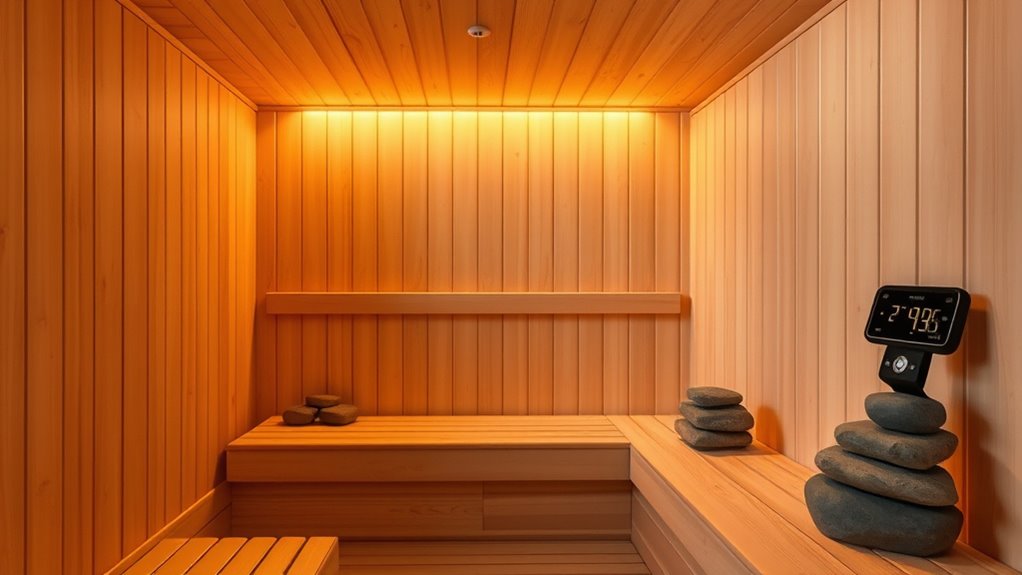To confidently size your sauna heater, start by measuring the interior length, width, and height accurately, then multiply these to find the room’s cubic volume. Larger spaces need more powerful heaters and better insulation, while smaller rooms heat faster. Guarantee proper ventilation and choose the right heater capacity—typically 6-8 kW for large, insulated saunas or 2-4 kW for small, infrared setups. Keep an eye on safety and efficiency; more details await as you continue.
Key Takeaways
- Measure interior dimensions accurately to calculate total cubic volume for proper heater sizing.
- Match heater wattage to sauna volume: larger rooms need higher-capacity heaters; smaller rooms need less.
- Ensure proper insulation and ventilation to maintain heat efficiency and safety.
- Avoid common mistakes like oversizing or undersizing heaters, which cause discomfort or insufficient heating.
- Follow safety guidelines and manufacturer instructions for installation, maintenance, and optimal performance.
Understanding the Basics of Sauna Room Volume
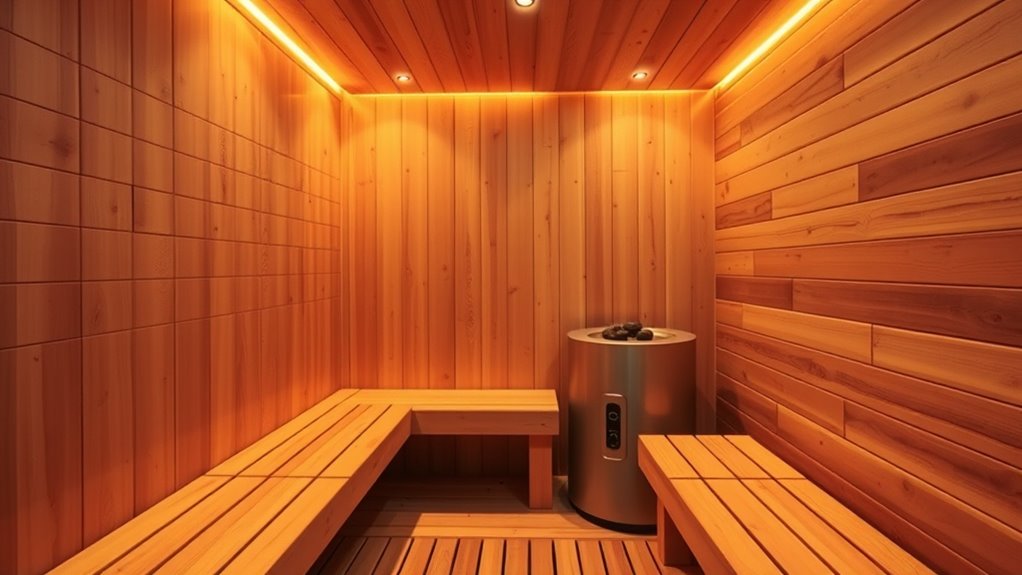
Understanding the basics of sauna room volume is essential because it directly influences how your heater performs and how comfortable the space feels. To achieve this, proper sauna insulation is key—it keeps heat consistent and reduces energy waste. Equally important is wood selection, as the right type of wood helps maintain heat and prevents excessive temperature fluctuations. When planning your sauna, consider how the materials you choose affect the overall volume and heat retention. A well-insulated, wood-lined sauna ensures even heat distribution and efficiency, making your sessions more enjoyable. Additionally, understanding the cost and budgeting involved in constructing your sauna can help you plan effectively and avoid unexpected expenses, ensuring your project stays on track. Remember, the size of your sauna isn’t just about square footage but also about how well it’s insulated and constructed with suitable wood to optimize heat and comfort.
Calculating Your Sauna’s Cubic Space

Start by measuring your sauna’s interior dimensions—length, width, and height. Then, multiply these figures to find the total cubic volume. Don’t forget to adjust your calculations for ventilation, which can affect the heater size needed. Additionally, considering the design style of your sauna can help determine the appropriate heater capacity for optimal comfort.
Measure Interior Dimensions
To accurately determine your sauna’s size, begin by measuring its interior length, width, and height with a tape measure. Ensuring measurement accuracy is key to capturing the true interior layout and avoiding errors that could affect heater sizing. Take your measurements at multiple points to account for any irregularities or uneven surfaces. Record each dimension carefully, noting the specific locations. These measurements will help you calculate the total cubic space, which is essential for selecting the right heater. Keep your tape measure straight and steady for consistent readings. By paying close attention to the interior layout and measurement accuracy now, you’ll set a solid foundation for the next steps in designing a safe, comfortable sauna. Additionally, understanding the flow rate of your sauna space can help optimize heater performance and energy efficiency.
Calculate Cubic Volume
Calculating your sauna’s cubic volume is straightforward once you have its interior measurements. Measure the length, width, and height of your sauna interior, then multiply these dimensions to get the total cubic footage. This number helps determine the right heater size and guarantees proper heat distribution. Proper insulation keeps the heat inside, making your heater’s job easier, while effective sauna lighting shouldn’t interfere with temperature control. If you plan to add benches or other features, include their space in your measurements for a more accurate volume. Knowing your sauna’s cubic volume guides you in selecting an appropriately sized heater, ensuring efficient heating and a comfortable experience. Accurate calculations lay a solid foundation for a safe, efficient sauna setup.
Adjust for Ventilation
Since proper ventilation impacts the effective volume of your sauna, you need to adjust your calculations to account for air exchanges and vents. Ventilation design influences airflow optimization, which is vital for safety and comfort. To do this, identify the size and number of vents, then reduce the calculated cubic volume accordingly. For example, if vents allow significant air exchange, your sauna’s effective volume decreases, meaning you might need a slightly smaller heater. Consider the airflow rate and how quickly air circulates within the space. Proper adjustment ensures your heater isn’t oversized or undersized, maintaining ideal heat distribution and air quality. Additionally, understanding the role of ventilation helps optimize your sauna’s overall environment. Remember, balancing ventilation and insulation creates a comfortable, efficient sauna environment tailored to your specific room design.
How Room Size Influences Heating Needs
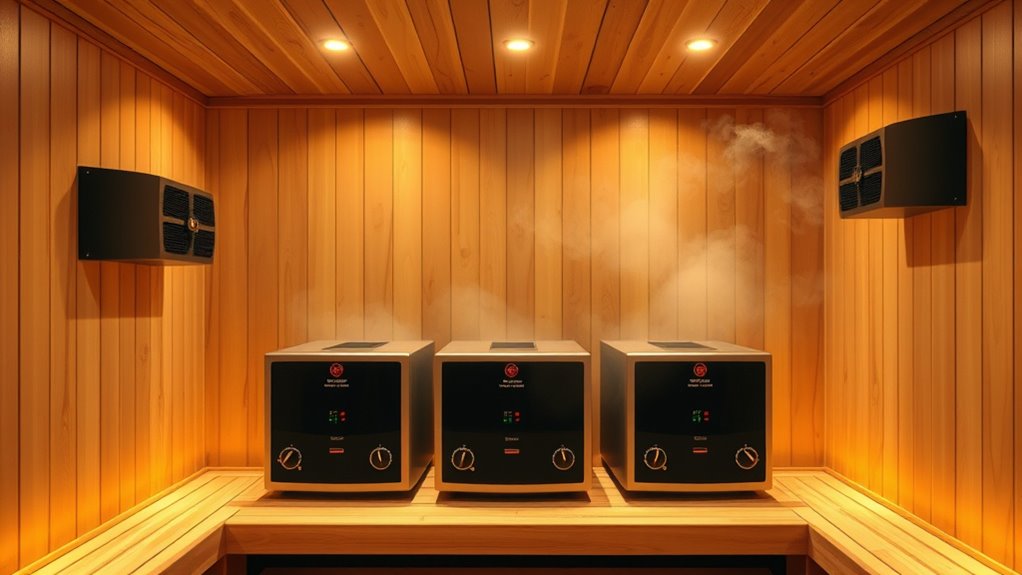
The size of your sauna room directly impacts the amount of heat needed to reach and maintain a comfortable temperature. Larger rooms require more powerful heaters and careful planning of insulation requirements to prevent heat loss. Smaller spaces heat quickly but may demand precise temperature control for comfort. When designing your sauna, consider aesthetic considerations, as room proportions influence the overall ambiance and style. Proper insulation guarantees efficient heating and energy savings, especially in larger rooms. Keep in mind that room volume also affects how evenly heat is distributed, impacting your comfort. A well-sized space with appropriate insulation minimizes heating costs and enhances relaxation. Balancing size and insulation helps you achieve the perfect sauna environment, tailored to your preferences. Additionally, insulation techniques play a crucial role in maintaining consistent heat levels and reducing energy consumption.
Choosing the Right Heater Power for Your Sauna
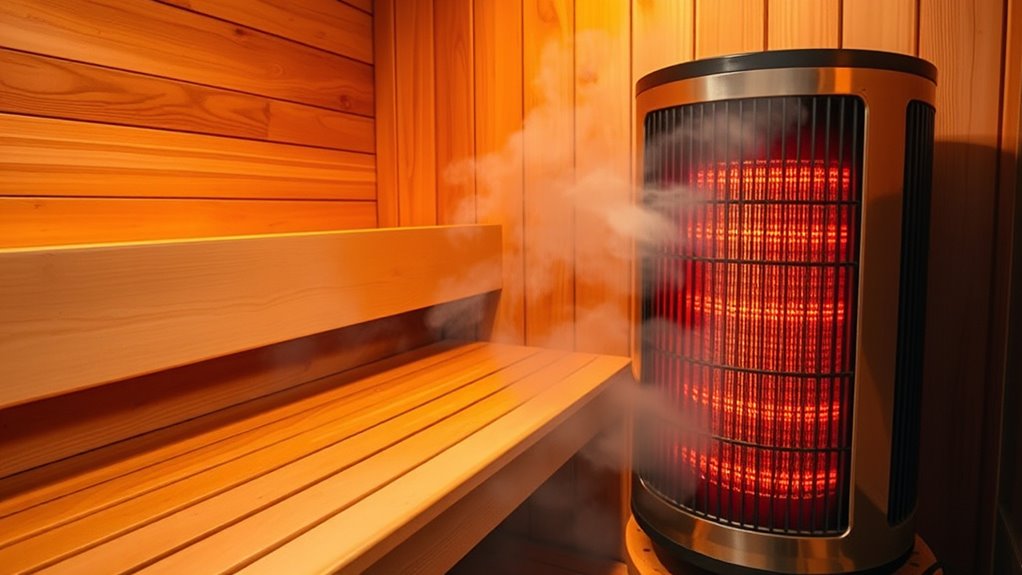
Choosing the right heater power depends on your sauna’s size, ensuring it heats efficiently without wasting energy. You should match the heater’s wattage to your room’s volume for ideal comfort. To achieve the best results, consider appropriate heating capacity based on the specific dimensions of your sauna.
Room Size Compatibility
Selecting the right heater power starts with understanding your sauna’s size. Proper room size compatibility guarantees efficient heating and comfort. Consider how insulation requirements influence heat retention—well-insulated spaces need less power. Aesthetic considerations also matter, as the heater should blend seamlessly with your design. To choose effectively, keep in mind:
- Exact interior dimensions of your sauna
- Insulation quality and material
- Ceiling height and shape
- Ventilation and airflow
- Desired temperature and heating speed
Matching heater capacity to these factors prevents under or over-heating, ensuring a cozy atmosphere. Remember, a heater that’s too powerful can cause energy waste and discomfort, while one that’s too weak won’t reach your preferred temperature. Proper sizing guarantees comfort and efficiency from the start, especially when considering necessary cookies to optimize your browsing experience.
Heater Power Recommendations
Once you understand your sauna’s size and insulation, determining the right heater power becomes straightforward. The key is selecting a heater that offers good heater efficiency while minimizing energy consumption. For small to medium saunas (around 4-6 cubic meters), a heater with 3-6 kW typically suffices. Larger rooms (7-10 cubic meters) may require 6-9 kW models. Keep in mind that an overpowered heater heats the space quickly but wastes energy and can be less efficient. Conversely, an underpowered heater struggles to reach and maintain desired temperatures, leading to higher energy consumption overall. Always choose a heater rated appropriately for your sauna’s volume, prioritizing efficiency to keep operating costs low and ensure consistent, comfortable heat. Incorporating automation’s role in business intelligence can help optimize your sauna’s energy use and temperature control over time.
The Importance of Ventilation and Airflow

Proper ventilation and airflow are crucial for creating a safe and comfortable sauna environment. They ensure ideal airflow efficiency, preventing overheating and reducing humidity buildup. Good ventilation design promotes fresh air intake and exhaust, maintaining air quality and temperature stability. Without proper airflow, you risk uneven heat distribution and potential health hazards. To achieve effective airflow, consider factors like vent placement, size, and number. Proper ventilation also helps moisture escape, protecting the sauna’s structure and materials. Efficient airflow management enhances comfort, ensuring you enjoy your sauna sessions safely. Remember, a well-ventilated sauna is key to a balanced environment. Invest in thoughtful ventilation design early on for a safer, more enjoyable sauna experience. Additionally, selecting the right earplugs for concerts can help protect your hearing during high-decibel sessions, further enhancing your overall relaxation and safety.
Common Mistakes to Avoid When Sizing Heaters
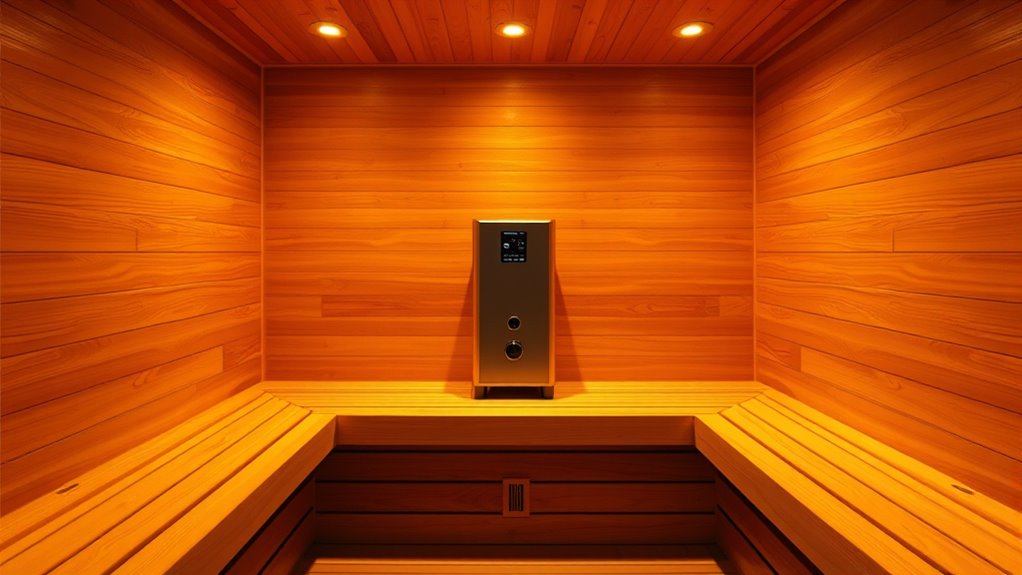
One common mistake to avoid when sizing heaters is choosing a model that’s too powerful or too weak for your sauna’s space. An oversized heater can cause uneven heating and make the environment uncomfortable, while an undersized one won’t reach your desired temperature. Proper heater placement is essential; position it where it can distribute heat evenly without being obstructed. Additionally, neglecting insulation materials can lead to heat loss and inefficiency, forcing you to select a larger heater than necessary. Use high-quality insulation to maintain consistent temperatures and reduce energy consumption. Avoid the temptation to skip planning your heater size carefully—doing so can result in discomfort, higher energy bills, and ineffective heating. Focus on accurate sizing, strategic placement, and good insulation for the best sauna experience.
Tips for Measuring and Planning Your Sauna
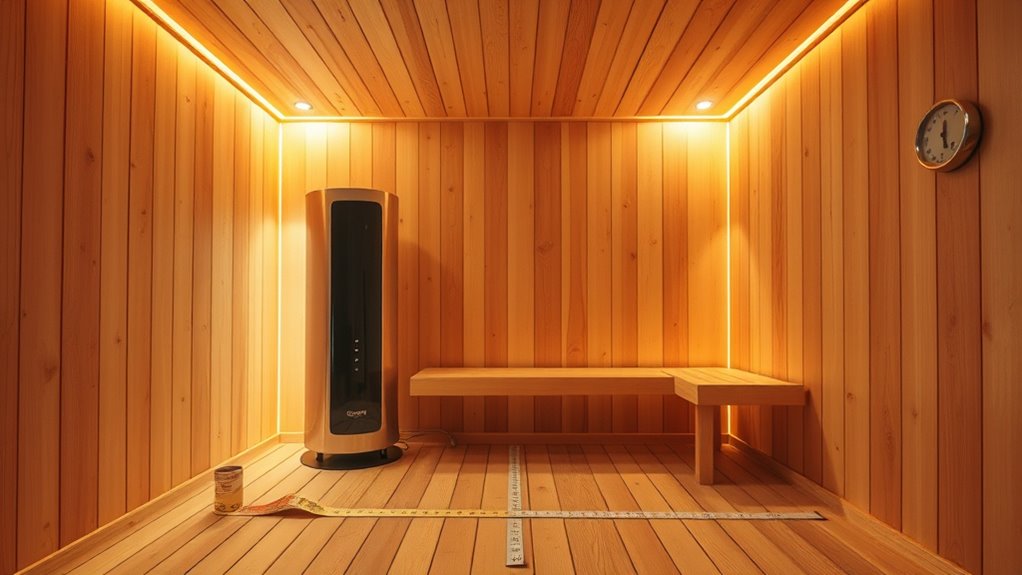
Accurate measurements are the foundation of a well-functioning sauna. To plan effectively, measure your space’s length, width, and height precisely. Consider how you’ll incorporate wood selection to guarantee durability and aesthetic appeal, choosing moisture-resistant types like cedar or spruce. Proper insulation techniques are essential; plan for thick insulation to maintain heat and energy efficiency. When measuring, account for door and ventilation placement to optimize airflow. Use a detailed sketch to visualize layout and heater placement, ensuring enough clearance for safety and comfort. Keep in mind that precise measurements help determine the correct heater size. Planning ahead with these tips ensures your sauna is well-insulated, efficiently heated, and built with quality materials.
Adjusting Heater Size for Different Sauna Types
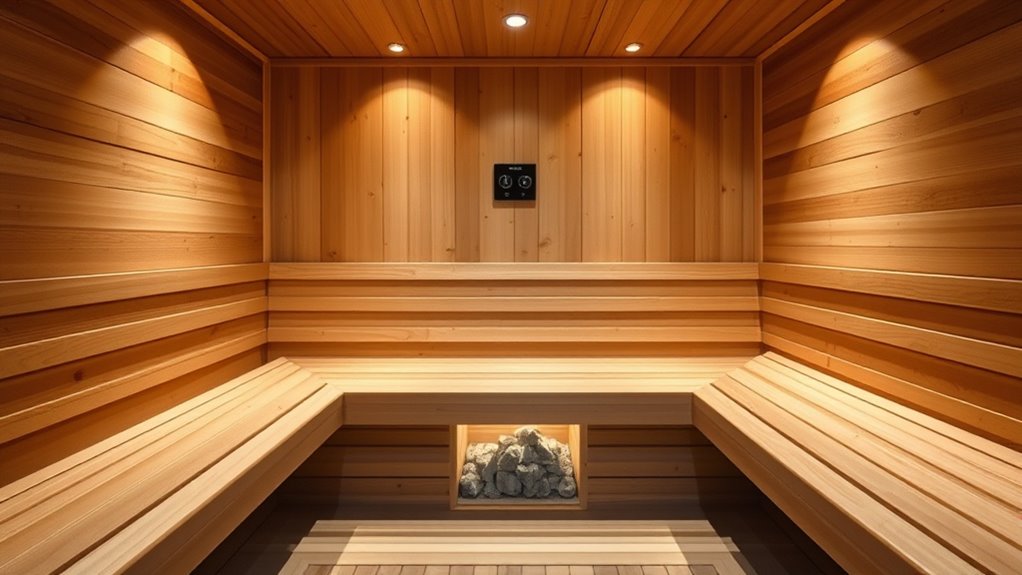
Since different sauna types have unique heating needs, adjusting your heater size is vital for peak performance. For example, a traditional dry sauna with thick insulation requires a heater with higher capacity to reach desired temperatures efficiently. Conversely, a low-insulation infrared sauna needs a smaller heater. Consider these factors:
| Sauna Type | Insulation Level | Recommended Heater Capacity |
|---|---|---|
| Traditional Dry | Thick | Higher (6-8 kW) |
| Infrared | Thin | Lower (2-4 kW) |
| Steam Sauna | Moderate | Moderate (4-6 kW) |
| Outdoor Sauna | Variable | Adjust based on insulation |
| Small Personal | Minimal | Smaller (1-2 kW) |
Adjust your heater size according to sauna insulation and room volume to ensure comfort and efficiency.
Ensuring Safety and Efficiency in Your Sauna Setup

Choosing the right heater size is just the first step; guarantee your sauna operates safely and efficiently is equally important. Proper sauna insulation helps maintain consistent temperatures and reduces energy consumption, making your setup more effective. During heater installation, follow manufacturer guidelines closely to prevent hazards and optimize performance. Regular maintenance, like checking wiring and cleaning the heater, keeps safety in check. To enhance safety and efficiency, consider these factors:
Proper insulation, secure installation, and regular maintenance ensure a safe, efficient, and enjoyable sauna experience.
- Use high-quality sauna insulation to prevent heat loss
- Securely install the heater according to safety standards
- Install a reliable thermostat for accurate temperature control
- Ensure proper ventilation to avoid moisture buildup
- Periodically inspect electrical connections and sauna insulation
These steps help create a safe, energy-efficient environment that maximizes your sauna experience.
Frequently Asked Questions
Can I Upgrade My Sauna Heater Later Without Remodeling?
Yes, you can upgrade your sauna heater later without remodeling if you choose a replacement heater compatible with your existing heater installation and sauna size. Make certain the new heater fits your current setup and matches the sauna’s volume for maximum performance. Check heater compatibility beforehand, and consider consulting a professional to handle the installation, so you avoid unnecessary modifications and ensure safety and efficiency.
How Does Insulation Affect Heater Size Requirements?
A touch of sophistication reveals that insulation’s impact on your sauna’s comfort is significant. When you improve insulation, your heater works more efficiently, meaning you can opt for a slightly smaller unit. Conversely, poor insulation requires a larger heater to compensate for heat loss. Proper insulation enhances heater efficiency, ensures consistent temperatures, and conserves energy, making your sauna experience more enjoyable and cost-effective over time.
Is There a Recommended Heater Brand for Beginners?
For beginners, a trusted brand like Harvia or Finnleo is a great choice because they prioritize heater safety and energy efficiency. These brands offer reliable, easy-to-use models that come with safety features and energy-efficient designs, helping you avoid common mistakes. Look for heaters with clear safety certifications and adjustable settings to guarantee safe operation while saving energy. Starting with a reputable brand makes your sauna experience safer and more enjoyable.
How Often Should I Maintain or Replace My Sauna Heater?
Did you know that a well-maintained sauna heater can last 8 to 15 years? You should stick to a regular maintenance schedule, inspecting and cleaning the heater every few months, and replace it when it shows signs of wear or reduced efficiency. Proper upkeep guarantees heater longevity, keeps your sauna safe, and maintains ideal performance. Don’t wait too long to replace a malfunctioning heater—your comfort and safety depend on it.
Can Portable Heaters Be Effective for Small Sauna Rooms?
Portable heater options can be effective for small sauna rooms if you choose the right size and type. They’re easy to install and great for DIY setups, but their heater effectiveness depends on room size and insulation. For maximum warmth, pick a portable heater designed for smaller spaces, and make certain it has safety features. While convenient, always check if it meets your sauna’s specific volume to get the best performance.
Conclusion
Now that you know how to size your sauna, you’re steering your project like a skilled captain steering calm waters. Getting the right heater and room size means smoother sailing, ensuring comfort and safety on your relaxation voyage. Remember, proper planning is your lighthouse guiding you toward a cozy, efficient sauna experience. With your newfound knowledge, you’re ready to turn your sauna dreams into a warm, inviting reality—so set sail with confidence!
